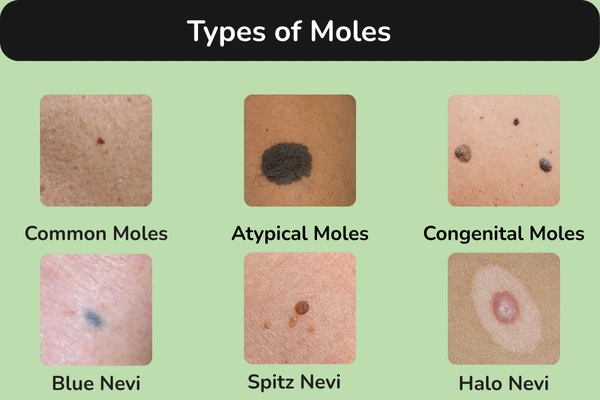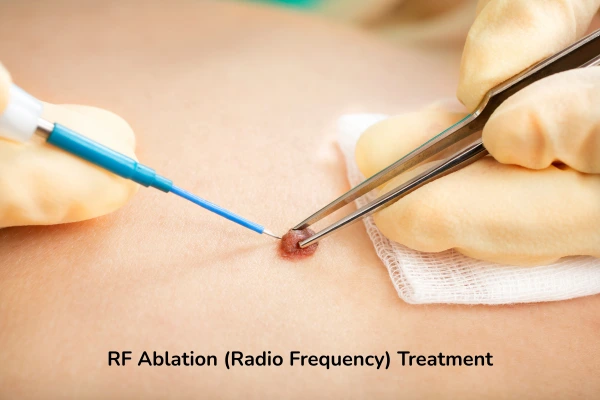Up to 25% OFF on Selected Treatments
-
Treatments
Acne and Scar
Pigmentation
Laser Hair Reduction
Dermato-surgery
Body
Anti Aging
Skin Rejuvenation
Others
- Clinics
- Blogs
Treatments
We all have them—those little spots scattered all over the body and face. Moles, medically known as nevi, are a common, discolored skin growth that can appear anywhere on the body. Unlike freckles or skin tags, moles are generally larger in size and can come in various shades, including tan, brown, pink, and skin-toned. They can be flat or raised, round or oval, and often emerge during childhood or adolescence, though they can develop later in life as well. While most moles are harmless, there is a chance of developing melanoma, a serious type of skin cancer. In this blog, understand the different types of moles on the face, Causes of moles on face, effective treatments, why do moles appear on the face and why professional mole evaluation and removal is necessary?
There are various types of moles that appear on your face:

| Mole Type | Appearance | Risk Level | Location |
| Common Moles | Small, round and brownish spots. Typically less than 6mm diameter. | Low | Any facial region |
| Atypical moles or dysplastic nevi | Larger than common moles, with irregular shaping and uneven coloring. And greater than 6mm diameter. | Moderate to high | Nose & cheek bones |
| Congenital Moles | Present at birth, large with irregular shape. Range from 1.5 centimetres to 20 centimetres | Moderate | Forehead and scalp |
| Blue nevi | Blue or black due to deep location of pigment producing cells. Small, round & raised | Low | Cheeks & scalp |
| Spitz nevi | Pink/red or brown in color resembling melanoma | Moderate | Cheeks, nose and bridge |
| Halo nevi | Mole with a pigmented ring | Low | Forehead temples |
Each type of moles require different care based on the cosmetic or medical concern.
If you are wondering why do moles appear on the face, you are not alone. Moles on the face, like those on other parts of the body, are caused by a variety of factors. Here are some of the must know causes of moles on face:
Understanding why do moles appear on face, and its causes can help in managing and monitoring moles for any signs of abnormal changes, which could indicate potential health issues like melanoma. In Bangalore like cities, prolonged sun exposure and high UV radiation can lead to pigmentation issues, so mole monitoring is vital.
Removing flat moles from your face permanently can be achieved through various methods, depending on the size, type, and location of the mole, as well as your personal preference and the dermatologist’s advice. Here are some effective methods:
This involves cutting out the mole and its surrounding tissue using a scalpel. This is often recommended for moles that are suspected of being cancerous or for those that are large.
Advantages:
Disadvantages:
This involves freezing the mole with liquid nitrogen, causing the mole cells to die and fall off.
Advantages:
Disadvantages:
Laser treatment uses focused light energy to break down the mole’s pigment cells. This method is suitable for smaller, flat moles that are not deeply rooted.
Advantages:
Disadvantages:

RF ablation involves radio waves to generate heat and destroy the mole tissue. Gradually, the mole shrinks and disappears.
Advantages:
Disadvantages:
Understanding the various professional treatments available to permanently remove flat moles from your face can help you make an informed decision.
Disclaimer: These til/mole removal methods from the face should only be performed by a qualified dermatologist.
The cost of laser mole removal on the face can vary depending on several factors, including location, dermatologists’ expertise, complexity of the mole, number of moles removed, and sessions needed. The cost of mole removal on the face ranges from Rs. 1000 to Rs. 10,000.


Evenly clinic can help you understand your moles and determine the best approach for removal that prioritises both safety and a beautiful cosmetic outcome.
Moles are a common skin occurrence, but some moles can be a warning sign of melanoma, a serious form of skin cancer. Understanding the different types of moles, causes of moles on face and knowing when to get them checked by a dermatologist is crucial for early detection and treatment. This blog by Evenly Clinic empowers you to take charge of your skin health!
Schedule Your Mole Check-Up Today!
Don’t wait! Schedule a consultation at Evenly Clinic to discuss your moles and explore safe removal options for a healthy, confident you. Remember, early detection is key!
Visit us at:
Evenly Skin and Hair Clinic – HSR Layout
Third Floor, 815, 27th Main Rd, above Bluestone, 1st Sector, HSR Layout, Bengaluru, Karnataka 560102
Evenly Skin and Hair Clinic – Jayanagar
35, Ground Floor, Vinyas Arcade, 11th Main Rd, Vishya Bank Colony, 5th Block, Jayanagar, Bengaluru, Karnataka 560041
For health-related information, follow us on Instagram!!!
What are moles?
Moles, medically known as nevi, are common skin growths caused by clusters of pigment-producing cells (melanocytes). They can appear anywhere on the body and vary in size, shape and colour.
Are moles cancerous?
Most moles are harmless. However, some moles can develop into melanoma, a serious type of skin cancer. It is essential to consult a dermatologist to get them checked if they find suspicious.
How can I tell if a mole is cancerous?
The ABCDE rule can help you monitor moles for changes that might indicate melanoma:
1. Asymmetry: Divide the mole in half. Do both sides look similar?
2. Border: Is the border smooth or irregular? Uneven borders can be a red flag.
3. Color: Is the mole a uniform color or a mix of colors? Uneven coloring is a cause for concern.
4. Diameter: Is the mole larger than a pencil eraser (around 6mm)? Larger moles warrant a check-up.
5. Evolving: Has your mole changed in size, shape, or color recently? Changing moles need a dermatologist’s eye.
Why would I want to remove a mole?
People choose mole removal for various reasons, including cosmetic concerns, irritation from clothing or jewelry, or suspicion of melanoma.
Does mole removal leave scars?
Some mole removal methods, like surgical excision, can leave scars. However, other methods like laser removal often result in minimal scarring. A dermatologist can discuss the likelihood of scarring for each removal option.
Why do moles appear on face?
Moles appear on face due to genetic predisposition, hormonal changes and sun exposure.
We hope this information has been helpful. If you have any skin and hair-related questions or would like to discuss personalized solutions, please reach out to us at 7337899030. Our team of experts is dedicated to providing personalized care that meets your unique needs. Take the first step towards a healthier, more confident you by scheduling a consultation with us today. Your journey to vibrant skin and stronger hair begins here.
Book an Appointment
Start your journey to healthy skin and hair today.
Leave a Comment